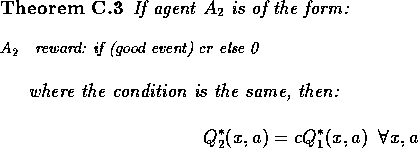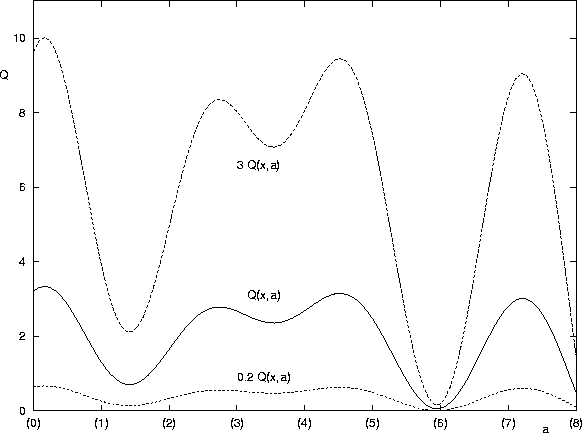But we could build a map of
![]() if we wanted.
if we wanted.
Pxa(r) not very useful.
Say in state x and:
Pxa(r=1) = 0.5,
Pxa(0) = 0.3,
Pxa(-1) = 0.2,
and:
Pxb(3) = 0.5,
Pxb(-3) = 0.5.
Take action a or b?
How do we decide?
Too much info!
We want to know E(r) for action decision.
And this is what Q-value is
(or, even more useful, E(R)).
Exercise - What is E(r) for each action?
Maybe
Pxa(r) is useful
where there is a large standard deviation:
Pxb(100) = 0.5,
Pxb(-100) = 0.5.
Q. What is E(r)?
E(r) doesn't tell full story here. May want to avoid the -100 at all costs.
[Although solution here, if you really must avoid a certain
punishment, is simply make that punishment -1000
(while keeping positive rewards fixed to less than 100).
The machine will soon learn to avoid it.]
In other words, who is to say that -100 is a big punishment?
It looks big, but if most rewards are +1000, then it is actually
a small punishment.
What matters is not the absolute sizes of r's,
but their relative sizes.
A machine with reward function:
"if good thing r = 1 million, if bad thing r = -1 million,
else r = 0"
will perform no different to a machine with reward function:
"if good thing r = 1, if bad thing r = -1,
else r = 0"
Proof: See following.
Q(x,a) =
c + γ c + γ2 c + ..to all Q-values.
Proof follows.
where r > s.reward: if (good event) r else s
Proof: Let us fix r and s and learn the Q-values.

for some real numbers ![]() .
The Q-value for a different action b will be:
.
The Q-value for a different action b will be:
![]()
where ![]() .
That is, e + f = c + d .
.
That is, e + f = c + d .
So whichever one of c and e is bigger defines which is the best action (which gets the larger amount of the "good" reward r), irrespective of the sizes of r > s.
To be precise, if c > e, then Q(x,a) > Q(x,b)
Note that these numbers are not integers - it may not be simply a question of the worse action receiving s instead of r a finite number of times. The worse action may also receive r instead of s at some points, and also the number of differences may in fact not be finite.
To be precise, noting that (c-e) = (f-d) , the difference between the Q-values is:

where the real number (c-e) is constant for the given two actions a and b in state x. (c-e) depends only on the probabilities of events happening, not on the specific values of the rewards r and s that we hand out when they do. Changing the relative sizes of the rewards r > s can only change the magnitude of the difference between the Q-values, but not the sign. The ranking of actions will stay the same.
For example, an agent with rewards (10,9) and an agent with rewards (10,0)
will have different Q-values
but will still suggest the same optimal action ![]() .
.
![]()
where p + q = 1 , and:
| E(rt+1) | = Σ y Pxa(y) r(x,y) |
| = Pxa(y1) r(x,y1) + ... + Pxa(yn) r(x,yn) | |
| = p' r + q' s |
Hence:

for some ![]() as before.
as before.
where r > s, can be normalised to the form:reward: if (good event) r else s
From Theorem C.1, this will have different Q-values but the same Q-learning policy. You can regard the original agent as an (r-s), 0 agent which also picks up an automatic bonus of s every step no matter what it does. Its Q-values can be obtained by simply adding the following to each of the Q-values of the (r-s), 0 agent:reward: if (good event) (r-s) else 0
![]()
where r > 0 .reward: if (good event) r else 0

Proof:
We have just multiplied all rewards by c,
so all Q-values are multiplied by c.
If this is not clear, see the general proof
Theorem D.1 below.
![]()
I should note this only works if: c > 0
![]() will have the same policy as
will have the same policy as ![]() .
We are exaggerating or levelling out the contour
in this Figure:
.
We are exaggerating or levelling out the contour
in this Figure:

Multiplying the reward by a factor multiplies the Q-values by that factor,
which either exaggerates or levels out the contour
![]() .
The agent will still rank the actions in the same order,
and still suggest the same preferred action.
.
The agent will still rank the actions in the same order,
and still suggest the same preferred action.
if (good event) 10 else 5is the same as (add -5):
if (good event) 5 else 0same as (multiply by 2/5):
if (good event) 2 else 0same as (add 3):
if (good event) 5 else 3
if (good event) r1 else r2is the same as:
if (good event) (r1-r2) else 0same as (multiply by something positive, r3 > r4):
if (good event) (r3-r4) else 0same as:
if (good event) r3 else r4
So any 2-reward fn can be transformed into any other, provided we don't change the order of the rewards.
For 3-reward (or more) agents the relative sizes of the rewards do matter for the Q-learning policy. Consider an agent of the form:
wherereward: if (best event)
else if (good event)
else

We show by an example that changing one reward in this agent while keeping others fixed
can lead to a switch of policy.
Imagine that currently actions a and b lead to the following sequences of rewards:
(x,a) leads to sequenceand then
forever
(x,b) leads to sequence
and then
forever
Currently action b is the best.
We lose ![]() on the fifth step certainly,
but we make up for it by receiving the payoff from
on the fifth step certainly,
but we make up for it by receiving the payoff from ![]() in the first four steps.
However, if we start to increase the size of
in the first four steps.
However, if we start to increase the size of ![]() , while keeping
, while keeping ![]() and
and ![]() the same,
we can eventually make action a the most profitable path to follow
and cause a switch in policy.
the same,
we can eventually make action a the most profitable path to follow
and cause a switch in policy.
The normalised agent will have the same policy.

Think of it as changing the "unit of measurement" of the rewards.
Proof:
When we take action a in state x,
let ![]() be the probability that reward
be the probability that reward ![]() is given to
is given to ![]() (and therefore that reward
(and therefore that reward ![]() is given to
is given to ![]() ).
Then
).
Then ![]() 's expected reward is simply c times
's expected reward is simply c times ![]() 's expected reward:
's expected reward:

It follows that
![]() and
and
![]() .
.
![]()
This only works if: c > 0
![]() will have the same policy as
will have the same policy as ![]() .
.
if (good event) r1 else if (bad event) r2 else r3where r1 > r3 > r2 (note order),
if (good) (r1-r3) else if (bad) (r2-r3) else 0i.e. (where (r3-r2) positive):
if (good) (r1-r3) else if (bad) - (r3-r2) else 0same as:
if (good) (r4-r6) else if (bad) - (r3-r2)(r4-r6)/(r1-r3) else 0same as:
if (good) r4 else if (bad) r6 - ((r3-r2)(r4-r6)/(r1-r3)) else r6
Can get 1st and last rewards to anything, but then restricted in what middle reward can be.
Can't transform it into arbitrary r5.
(r3-r2)(r4-r6)/(r1-r3) > 0So:
r6 - ((r3-r2)(r4-r6)/(r1-r3)) < r6
And:
r6 < r4
3-rewards - 2 good things - 2 goals - many ways to balance how you pursue both - a few hits of middle r may compensate for losing one high r - may pursue middle r and ignore higher one